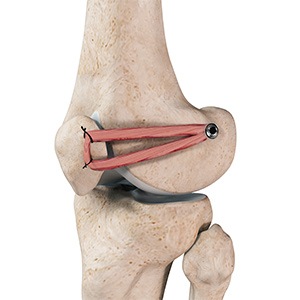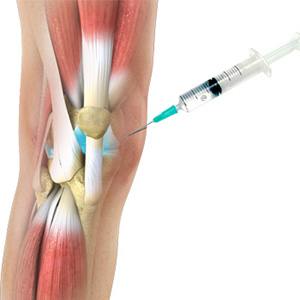- Anatomy
- Conditions
- Procedures
Total Knee Replacement

Total knee replacement, also called total knee arthroplasty, is a surgical procedure in which the worn out or damaged surfaces of the knee joint are removed and replaced with an artificial prosthesis.
Subvastus Muscle Sparing Total Knee Replacement

Subvastus Muscle Sparing Total Knee Replacement (SV-MS TKR) is a surgical technique in total knee arthroplasty (TKA) that prioritizes preserving the vastus medialis muscle and its neurovascular integrity. Unlike traditional approaches that often involve extensive manipulation or splitting of the quadriceps muscles, the subvastus approach focuses on minimizing soft tissue trauma, which is a key determinant of recovery outcomes.
Pronto Knee Joint Replacement

Pronto Knee Joint Replacement is a minimally invasive surgical technique designed to replace the knee joint with less trauma to the surrounding tissues. This approach typically aims to reduce recovery time and postoperative pain compared to traditional knee replacement surgery.
Robotic Assisted Knee Replacement

Robotic-assisted knee replacement surgery is an alternative to the conventional knee replacement procedure. It is performed using robotic-arm technology that allows your surgeon to precisely perform the surgery through a smaller incision as compared to traditional surgery.
ROSA Robotic Total Knee Replacement

ROSA® Knee System is a robotic surgical assistant developed by Zimmer Biomet that enables surgeons to carry out knee replacement procedures with greater precision and a higher standard of care during knee replacement surgery. The ROSA robotic system utilizes real-time information and assists surgeons with precise placement of the knee implants based on a person’s unique knee anatomy.
Same Day Total Knee Replacement

Total knee replacement is the surgical treatment for knee arthritis, where the damaged knee is removed and replaced with an artificial knee implant. Traditionally, the procedure required a postoperative hospital stay of several days, but with recent advances such as improved perioperative anesthesia, minimally invasive techniques, and initiation of rehabilitation protocols soon after surgery, you may be allowed to go home on the same day as the surgery.
Rapid Recovery Knee Replacement

Rapid recovery knee replacement, also known as an outpatient knee replacement, is an innovative procedure that is performed to replace a damaged knee joint with a prosthesis using minimally invasive techniques and surgical instruments that minimize post-operative pain and discomfort and promote faster recovery for patients.
Partial Knee Replacement

Unicompartmental knee replacement is a minimally invasive surgery in which only the damaged compartment of the knee is replaced with an implant. It is also called a partial knee replacement. The knee can be divided into three compartments: patellofemoral, the compartment in front of the knee between the kneecap and thighbone, the medial compartment, on the inside portion of the knee, and lateral compartment which is the area on the outside portion of the knee joint.
Patellofemoral Knee Replacement

Traditionally, arthritis in only one compartment of the knee is treated by partial knee replacement surgery. Patellofemoral knee replacement is a minimally invasive surgical option performed in the patellofemoral compartment only, preserving the knee parts not damaged by arthritis as well as the stabilizing anterior and posterior cruciate ligaments (ACL and PCL).
Knee Surgery

Knee surgery is a surgical procedure for the treatment of a knee injury or condition. The procedure involves repairing diseased or damaged structures of the knee joint in order to eliminate pain and restore normal function. The knee is a complex joint made up of different structures - bones, tendons, ligaments, and muscles.
Knee Trauma Reconstruction

Knee trauma reconstruction is a surgical procedure to repair a soft-tissue injury of the knee such as a torn ligament using a tissue graft or replacing the damaged bony surfaces of the knee joint with an artificial knee joint called a prosthesis. Artificial knee joints are usually made of metal, ceramic or plastic, and consist of the femoral and the tibial components.
Knee Arthroscopy

Knee arthroscopy is a common surgical procedure performed using an arthroscope, a viewing instrument, to diagnose or treat a knee problem. It is a relatively safe procedure and you will usually be discharged from the hospital on the same day of surgery.
Patellar Tendon Repair

Patellar tendon repair is the surgery performed to reattach the torn tendon to the kneecap and to restore normal function in the affected leg. Patella tendon rupture is the rupture of the tendon that connects the patella (kneecap) to the top portion of the tibia (shinbone).
Quadriceps Tendon Repair

Quadriceps tendon is a thick tissue located at the top of the kneecap. The quadriceps tendon works together with the quadriceps muscles to allow us to straighten our leg. The quadriceps muscles are the muscles located in front of the thigh.
Meniscal Surgery

Meniscal surgery is a surgical procedure employed for the treatment of torn or damaged meniscal tissues in the knee. It is mostly performed as a minimally invasive keyhole procedure. Two wedge-shaped cartilage pieces are present between the thighbone and the shinbone.
Partial Meniscectomy

Partial meniscectomy is a surgical procedure to remove the torn portion of the meniscus from the knee joint. Meniscal tears can occur at any age, but are more common in athletes playing contact sports. These tears are usually caused by twisting motion or over-flexing of the knee joint.
Chondroplasty

Chondroplasty is a surgical procedure to repair and reshape damaged cartilage in a joint. The procedure involves smoothing degenerative cartilage and trimming any unstable flaps of cartilage. Chondroplasty may be recommended if you have mild to moderate cartilage wear or a cartilage injury in your joint, rather than widespread or irreparable cartilage damage.
Knee Osteoarthritis Treatment

Knee osteoarthritis (OA) treatment refers to the various approaches involved in the treatment of the degenerative joint condition called osteoarthritis. The knee joints are lined by soft articular cartilage that cushion the joints and aid in smooth movement of the joint bones. Knee OA occurs when the cartilage in the knee joint wears down over time, leading to pain, stiffness, swelling, and decreased function.
Intraarticluar Knee Injection

Knee pain and stiffness can be disabling and difficult to treat. It can limit an individual’s lifestyle and negatively impact body image and emotional well-being. An intra-articular knee injection is a very effective form of treatment where medicine is delivered directly into the knee joint with the primary objective of relieving pain from conditions such as arthritis.
Knee Steroid Injection

Knee pain and stiffness can be debilitating, limiting mobility and negatively impacting daily activities. A knee steroid injection is a minimally invasive treatment that delivers corticosteroid medication directly into the knee joint to reduce inflammation and relieve pain caused by conditions such as arthritis and injury-related inflammation.
Viscosupplementation

Viscosupplementation refers to the injection of a hyaluronan preparation into the joint. Hyaluronan is a natural substance present in the joint fluid that assists in lubrication. It allows the smooth movement of the cartilage-covered articulating surfaces of the joint.












